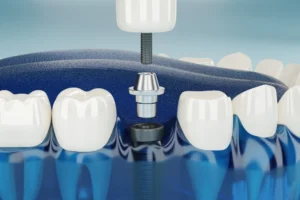How Long Do Dental Implants Last? | Trusted Implant Dentistry in Kannamangala, Bengaluru
Dental implants are designed to be a long-term, often permanent solution for missing teeth. In growing urban areas like Kannamangala, Kadugodi, and Whitefield in Bengaluru, they are one of the most preferred treatments for restoring smile and function. These implants are surgically placed into the jawbone, where they naturally fuse with the surrounding bone through a process called osseointegration. This powerful bonding allows the implant to function just like a natural tooth root, offering a strong, stable base for a replacement tooth or crown.
With advanced implant care available in Bengaluru, especially at clinics like Hashtag Smile Medical & Dental Aesthetics, the titanium implant itself can last a lifetime—if supported by regular dental visits and excellent oral hygiene. However, the crown attached to the implant may need replacement over time due to natural wear and tear. On average, around 50 to 80 percent of dental crowns may require replacement within 15 to 20 years, depending on individual bite pressure, diet, and dental habits.
For patients near Whitefield or Kadugodi, our Bengaluru-based dental team emphasizes routine checkups, precision implant techniques, and patient education. These steps are essential in helping you maximize the lifespan of your dental implants and crowns, ensuring lasting comfort and function for years to come.

Types of Dental Implants: What You Need to Know
Dental implants are a reliable and long-lasting solution for missing teeth. There are two main types of dental implants commonly used in modern dentistry: Endosteal implants and Subperiosteal implants. Each type is suited to different jaw structures and patient needs.
1. Endosteal Implants
Endosteal implants are the most commonly used dental implants. Shaped like small screws or cylinders, they are typically made from titanium or ceramic and are surgically inserted directly into the jawbone.
How the Procedure Works:
- The process is done in two main steps under local anesthesia, so you won’t feel any discomfort.
- First, your oral surgeon will make a small incision in your gums and drill into the jawbone to insert the implant.
- Once placed, the area is allowed to heal. During this time, osseointegration occurs—where the bone fuses with the implant, forming a strong foundation.
- After healing, a crown is attached to the implant using a connector called an abutment.
Additional Procedures (if needed):
In some cases, extra steps may be required to ensure your jawbone is strong enough to support the implant. These may include:
- Bone grafting
- Sinus lift
- Ridge expansion
These procedures help provide a stable base for successful implant placement.
2. Subperiosteal Implants
Subperiosteal implants are an alternative for people who do not have enough healthy jawbone for traditional implants and prefer to avoid bone grafting procedures. Instead of being inserted into the jawbone, these implants sit on top of the bone and beneath the gum tissue.
How the Procedure Works:
- First, your dentist will take a detailed impression of your jawbone to ensure the implant fits precisely.
- This involves making an incision to expose the jawbone.
- Once the area has healed, the metal frame of the implant is placed under the gum but over the jawbone.
- The frame includes small metal posts that stick out slightly from the gums.
- During a follow-up visit, artificial teeth (crowns) are attached to these posts.
What Are Mini Dental Implants and How Long Do They Last?
Mini dental implants are smaller, less invasive alternatives to traditional dental implants. They are typically used to stabilize dentures or replace smaller teeth in areas with less bone density. While not as long-lasting as standard implants, mini dental implants can last anywhere from 6 to 10 years or more with proper oral care and regular dental checkups.
What Factors Can Cause Dental Implant Failure?
Dental implants are a long-lasting and reliable solution for missing teeth, often lasting a lifetime with proper care. However, in some cases, implants can fail. Most implant failures occur when something interferes with osseointegration, the natural process where the implant bonds with the jawbone during healing.
Below are the key factors that can influence the success or failure of dental implants:
1. Poor Oral Hygiene and Maintenance
Just like natural teeth, dental implants require consistent care. Neglecting oral hygiene can lead to plaque buildup, which may cause gum infections such as peri-implant disease. If untreated, this condition can progress to peri-implantitis, a serious infection that can damage the surrounding bone and result in implant failure.
To prevent this:
- Brush at least twice daily
- Floss once a day
- Limit sugary foods and drinks
- Visit your dentist every 6 months
2. Insufficient Jawbone
For an implant to stay secure, it must be firmly anchored in the jawbone. A lack of sufficient bone can lead to instability and failure. Before placing implants, your dentist will evaluate bone quality using X-rays or 3D imaging.
If there’s not enough bone, you may need bone grafting, a sinus lift, or other preparatory procedures.
Bone loss over time due to osteoporosis, peri-implant disease, or medical conditions can also weaken support for the implant.
3. Smoking
Smoking is a well-known risk factor for implant failure. Studies show that implant failure rates are higher in smokers (about 11%) compared to nonsmokers (5%). Smoking impairs blood flow, delays healing, and increases the risk of gum disease, all of which can compromise implant stability.
4. Teeth Grinding (Bruxism)
Chronic teeth grinding or occlusal trauma can cause:
- Fracture of the implant or crown
- Loosening of the screw
- Interruption of osseointegration
The constant pressure and micro-movements caused by grinding can prevent the implant from properly fusing with the jawbone.
5. Underlying Medical Conditions
Certain health conditions can negatively impact healing and bone integration, increasing the risk of implant failure. These include:
- Diabetes
- Osteoporosis
- Autoimmune disorders
- Bleeding disorders
- Cardiovascular conditions such as high blood pressure or heart failure
A thorough medical evaluation is crucial before proceeding with implants.
6. Medications or Treatments
Some medications and treatments can interfere with healing or bone formation, such as:
- Immunosuppressants
- Blood thinners
- Radiation therapy to the head or neck
Always inform your dentist of any current medications or treatments you’re undergoing.
7. Age-Related Factors
Older adults may have slower healing and reduced bone density, which can increase the likelihood of implant complications. While age alone isn’t a disqualifier, overall health and bone quality are important considerations.
8. Inexperienced Implant Surgeon
The success of a dental implant heavily depends on the skill of the surgeon. Implant failure may occur due to:
- Poor planning or design
- Improper implant placement
- Tissue trauma during surgery
- Placing the crown too soon before full healing
What Happens If a Dental Implant Fails?
If a dental implant begins to fail, it’s important to see your dentist or periodontist as soon as possible. Early detection can help prevent further complications and improve the chances of saving the implant or replacing it successfully.
Common Signs of Implant Failure Include:
- Mobility: The implant feels loose or moves when touched
- Pain: Persistent discomfort, especially while biting or chewing
- Gum Symptoms (Signs of Peri-Implantitis):
- Redness around the implant site
- Swelling of the surrounding gums
- Bleeding when brushing or flossing
- Gum recession exposing the implant
- Pus or discharge near the implant
- Redness around the implant site
- Mobility: The implant feels loose or moves when touched
If you notice any of these warning signs, don’t delay—schedule a dental evaluation promptly. Early treatment can prevent the problem from worsening and help protect your overall oral health.
How Is a Failed Dental Implant Treated?
If a dental implant fails, the first step is to have it safely removed, typically under local anesthesia. Depending on the cause of failure and the condition of the surrounding bone and gum tissue, replacing the implant may be possible. Studies show that re-implanting in the same area has an average success rate of around 71%.
1. When Bone Loss Has Occurred:
If the failed implant is accompanied by bone loss, a bone graft may be necessary to rebuild the jawbone. This procedure helps regenerate bone tissue, creating a stable foundation for a future implant. In such cases, several months of healing may be required before placing a new implant.
Other Treatment Options:
If replacing the implant isn’t possible or not preferred, alternative solutions include:
- Dental bridges
- Partial or full dentures
These options can effectively restore function and aesthetics even without a dental implant.
2. Treating Peri-Implantitis (Without Removing the Implant):
In cases where peri-implantitis is present but bone loss is minimal, the implant might still be saved. Treatment typically involves:
- Deep cleaning and decontamination of the implant surface
- Antibiotic therapy to control infection
- Regular follow-ups to monitor healing
3 Effective Options for Replacing Missing Teeth
Missing teeth can occur due to gum disease, tooth decay, injury, or even genetic conditions. No matter the cause, replacing a missing tooth is important—not just for restoring your smile, but also for maintaining proper chewing function, speech, and jawbone health.
If you’re considering treatment to restore your smile, here are three reliable options for replacing missing teeth, along with the benefits, drawbacks, and cost considerations of each:
1. Dental Implants
Dental implants are considered the gold standard for tooth replacement. They involve surgically placing a titanium post into the jawbone, which serves as an artificial root for a crown.
Pros:
- Natural look and function
- Long-lasting (often decades)
- Helps preserve jawbone density
Cons:
- Requires surgery
- Longer treatment timeline
- Higher upfront cost
2. Dental Bridge
A dental bridge fills the gap left by a missing tooth by anchoring to adjacent teeth. It usually involves placing crowns on the neighboring teeth and attaching a false tooth (pontic) between them.
Pros:
- Fixed (non-removable)
- Faster than implants
- More affordable than implants
Cons:
- May require healthy teeth to be filed down
- Doesn’t prevent jawbone loss
3. Partial Denture
A partial denture is a removable appliance used to replace one or more missing teeth. It’s custom-made to fit comfortably in your mouth and blend with your natural teeth.
Pros:
- Non-invasive and affordable
- Easily removable for cleaning
- Quick to fabricate and fit
Cons:
- Less stable than bridges or implants
- May feel bulky at first
- Requires regular maintenance and adjustment
Why Replacing Missing Teeth Matters
Ignoring missing teeth can lead to problems like:
- Shifting of nearby teeth
- Difficulty chewing or speaking clearly
- Jawbone shrinkage over time
- Increased risk of gum disease
What’s the Impact of Missing Teeth?
At first glance, missing a tooth—especially one that’s not visible—might not seem like a big concern. For instance, if the gap is toward the back or side of your mouth, you might hardly notice it. However, even a single missing tooth can disrupt the harmony of your bite and gradually affect your oral health and overall well-being.
Here’s How Missing Teeth Can Impact You Over Time:
1. Difficulty with Chewing and Eating
When a tooth is missing, chewing food can become uncomfortable or uneven. You may begin to favor one side of your mouth, which can strain your jaw muscles and lead to joint pain or tension over time. In some cases, people end up eating more slowly or avoiding certain foods altogether.
2. Changes in Speech
Teeth play an essential role in how we articulate certain sounds. Missing front or side teeth can lead to slurred or unclear speech, which can affect confidence in social or professional settings.
3. Facial Structure Changes
Teeth support your facial muscles and maintain your natural face shape. Tooth loss—especially when multiple teeth are missing—can lead to a sunken or aged appearance as the jawbone begins to shrink and facial volume diminishes.
4. Shifting of Remaining Teeth
Your teeth are designed to stay in alignment with the help of their neighbors. When a tooth is missing, adjacent teeth may start to tilt or shift into the empty space, which can:
- Throw off your bite alignment
- Lead to tooth grinding (bruxism)
- Increase tooth sensitivity
- Cause difficulty in chewing or discomfort in your jaw
5. Long-Term Oral Health Issues
Over time, the changes in bite and jaw pressure from missing teeth can lead to TMJ disorders, bone loss, and even gum disease if not properly managed.
Are You a Good Candidate for Endosteal Implants?
Endosteal implants are the most commonly used type of dental implant, but they’re not suitable for everyone. Your dentist or oral surgeon will evaluate several factors to determine if this treatment is right for you.
You may be a viable candidate if you:
- Have one or more missing teeth
- Are in good general health
- Maintain excellent oral hygiene
- Have healthy gums, free from periodontal (gum) disease
- Have a fully developed jawbone
- Have adequate bone density to support the implant
- Are unable or unwilling to wear dentures
What If You’re Not a Candidate for Endosteal Implants?
Not everyone is an ideal candidate for endosteal dental implants. If your dentist or oral surgeon determines that this type of implant isn’t suitable for you, don’t worry—there are several effective alternatives and preparatory procedures that can still make implant placement possible.
Alternative Options and Preparatory Treatments
1. Subperiosteal Implants
If you don’t have sufficient jawbone for traditional implants and prefer to avoid extensive surgery, subperiosteal implants may be recommended. These implants are placed on top of the jawbone, just beneath the gum tissue, instead of being inserted into the bone.
2. Bone Augmentation
If your jawbone lacks the required density or volume, bone augmentation may be needed. This procedure uses bone grafts and growth factors to rebuild and strengthen the jawbone, creating a solid foundation for future implants.
3. Ridge Expansion
In cases where the jaw isn’t wide enough to support an implant, your dentist may perform a ridge expansion. This involves creating a small ridge along the jaw and inserting bone graft material to widen and reinforce the bone structure.
4. Sinus Augmentation (Sinus Lift)
If implants are planned in the upper jaw and there’s insufficient bone height near the sinuses, a sinus lift may be recommended. This involves gently lifting the sinus membrane and adding bone beneath it to support an implant.
Why These Procedures Matter
These advanced techniques are often used to prepare your jawbone to successfully hold an implant. While they may extend the overall treatment timeline, they significantly improve your chances of long-term implant success.
Dental Implant vs. Bridge Cost: What You Need to Know in India
When deciding between a dental implant and a dental bridge, cost is often a key consideration. While dental bridges are generally more affordable upfront, implants offer long-term durability and fewer replacements over time.
How to Prevent Dental Implant Failure
Although not all failures can be avoided, there are several important steps you can take to reduce your risk:
Maintain Excellent Oral Hygiene
- Brush at least twice daily
- Floss carefully around the implant
- Use an antibacterial mouthwash to control plaque
Visit Your Dentist Regularly
- Schedule a dental check-up every 6 months
- Get professional cleaning and early screening for gum disease
Avoid Tobacco Products
- Smoking reduces blood flow to the gums, delays healing, and increases the risk of infection and implant failure
Boost Your Bone Health
- Increase your calcium intake through foods like milk, cheese, broccoli, and yogurt
- Consider calcium or vitamin D supplements if advised by your dentist
Manage Teeth Grinding (Bruxism)
- Ask your dentist about getting a custom mouth guard if you grind your teeth at night, as grinding can loosen or damage the implant
Avoid Harmful Habits
- Refrain from chewing on hard items like ice, candies, or pens
- Avoid using your teeth to open packaging or bite nails
Don’t Rush into Immediate Tooth Replacement
- In some cases, it’s better to wait before placing a crown to allow the implant to fully integrate with the bone (osseointegration)





